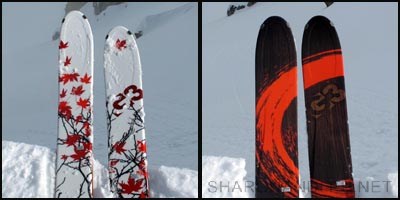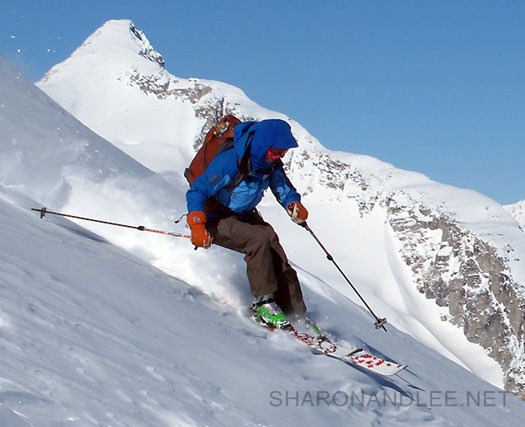Sharon Bader and Lee Lau
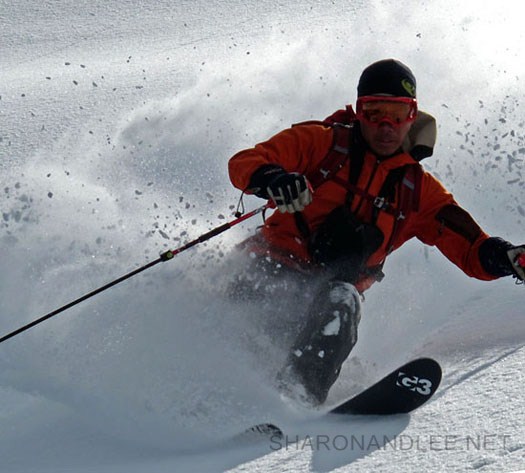
Testing G3 Zenoxides in the Duffey, BC.
In the time-honored tradition of garage entrepreneurship, Oliver Steffen founded G3 in 1995 making avalanche probes to order, mainly for the Vancouver market. During subsequent years G3 broke through to big-time backcountry skiing products with a suite of telemark bindings, avalanche safety gear and ski touring items. Basically a research and development company with a sales & marketing bent, G3 then forayed into skis and now, with the recent launch of the Onyx, into the world of tech bindings.
Following is a review of two skis in G3’s lightweight touring-oriented “Mountain” Series – the Tonic and Zenoxide. Also overviewed is the the Onyx binding (which were provided with the skis), G3 skins and G3’s new Speed Probe. The skis were skied by both Sharon and Lee in similar conditions.
Lee’s personal biases
I weigh 165 lbs and ski mainly in the Coast Mountains of British Columbia in the Vancouver/Whistler area. My skiing is usually in fairly high moisture-content snow and I am not a finesse skier. Accordingly, my preference is for bigger skis and boots. I ski about a 100 days a season, 70% of which days involves some backcountry skiing. I spent 10 days on the Zenoxide and 3 days on the Tonic. Almost all these days except for two were spent touring. I used a Dynafit ZZeus boot with these skis. My personal skis are BD Megawatts, BD Verdicts (older foam-core), Atomic TM:ex.
Sharon’s personal biases
I weigh 150lbs and have been skiing in the Vancouver area ( North Shore, Whistler, Mt. Baker) for 30+ years. I have been backcountry skiing for 20 of those. I average 80 days of skiing per year, most of those touring. I skied on the Tonics 10 days, the Zenoxides 6. Both skis saw light powder touring and heavy powder inbounds conditions, and some touring conditions were variable. Boots I used with these skis were the Scarpa Shaka or Scarpa Gea. My other touring skis are BD Verdicts and Movement Sparks. My inbounds skis are Movement Baggies and Volkl 5 stars.
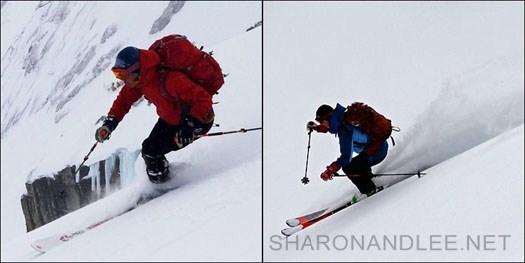
Lee on Tonics, Sharon on Zenoxides
TONIC AND ZENOXIDE SKIS
Tonic is unchanged for 2011 from the 2010 version. Main characteristics are an early rise tip (think of this as a rise in the tip of the ski that starts a bit earlier from boot sole center than a traditional rise ski – see profile pictures of the ski below for more of an idea), poplar wood core and reduced camber underfoot. The 2011 Tonic sports an award winning white and red maple leaf graphic. Tonic is still a beefy 3.76 kg / 8.1 lb for the 177mm ski (weights are per pair); it is the slightly heavier but quicker turning ski of the Mountain Series. In the 177 length, the turning radius of the ski is approximately 22m with dimensions of 132/100/123 (unchanged between lengths).
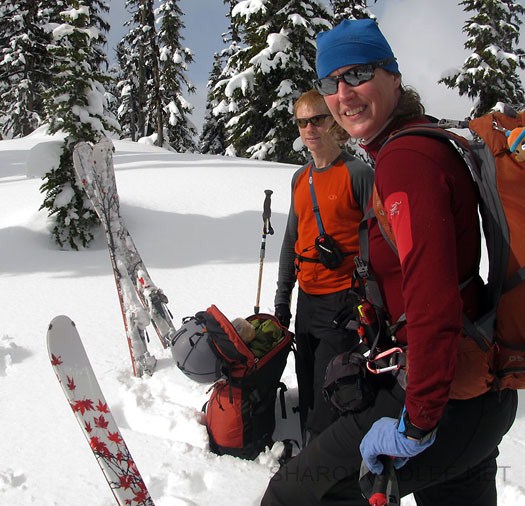
We met the designer of the G3 Tonic ski graphics on the Duffey!
The 2010-2011 Zenoxide differs from the 2010 version by being stiffer, lighter and with altered dimensions (same underfoot width of 105mm but a narrower tip and tail resulting in a less turny ski). Weight is reduced by cap construction. Like the Tonic it too has an early rise tip and is constructed with a lightweight wood paulownia/poplar core. The 2011 Zenoxide weighs in at 3.3kg / 7.2lb for the 178 ski, a substantial 300g weight reduction (per pair) from the past year’s ski. In the 185 length, the Zenoxide’s turning radius is approximately 28m with dimensions of 131/105/123 (unchanged over length).
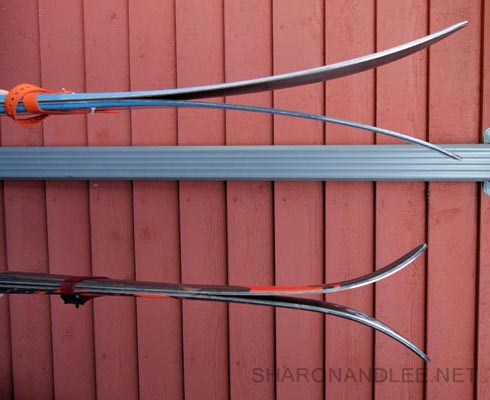
Compare the rockered tip of a BD Megawatt (top) to the 'early rise' tip of the more conventional G3 Zenoxide (bottom).
Test conditions
Lee and Sharon skied the 185 G3 Tonic and 185 Zenoxide inbounds in Blackcomb and Whistler during a powder frenzy weekend, typical weekend of backcountry touring in the Duffey, as well as at Battle Abbey– a ski touring lodge in the Selkirks in the British Columbia interior. The inbounds conditions included light, heavy and packed powder as well as groomed runs. The ski conditions in the Selkirks were mainly powder along with infrequent bouts of wind affected snow. Lee’s focus is on the Zenoxide while Sharon’s focus is on the Tonic, but both skied the other G3 skis and provide cursory impressions.
Sharon’s Tonics (and Zenoxide) Impressions
The 185 Tonics were a lot of ski for little old me. In all conditions, if I got a little bit back seated they would accelerate away from me. I was able to reign them in but I found that the Tonics performed best if I stayed centered. When I was on top of my game the Tonics would reward me with speed, stability and very fast acceleration out of the turns. In the 185 length (as compared to the 177 length) didn’t always want to start a turn, seeming to rather go straight, but once in the turn it would actively accelerate out. They would also plow effortlessly through chunder and over the wind affected.
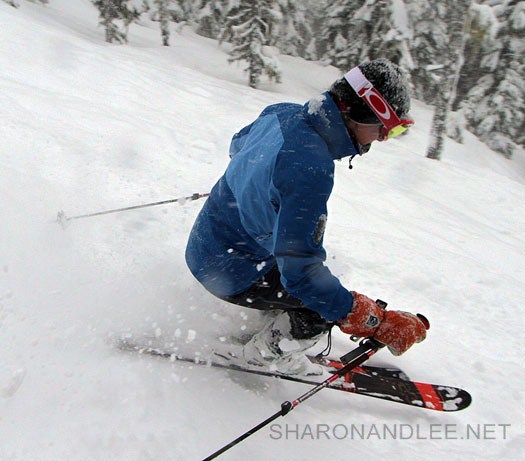
Inbounds 'ski testing' at Blackcomb.
I also had the opportunity to ski on the 2010 177 Tonic inbounds at Blackcomb in powder conditions. I would agree with the previous Wildsnow Review. i.e, that in the 177 length, the Tonic is a much quicker, easier ski that did not compromise at straight lining speed. While the 177 G3 Tonics liked to turn, it was just as comfortable straight lining past the Mountain Safety people (who seem to take offense to such ski technique). In all conditions skied the Tonic was never deflected by wind affected snow, chunder — or even small trees (next career, a firewood business).
The Zenoxides were a more forgiving but less turny ski. They were not as demanding a ski and I could relax more on them. Since they preferred to go straight they required more input to make them turn. Once in the turn they were very quick out of the turn. They were equally stable at speed and in variable conditions as the Tonics.
Lee’s Zenoxide (and Tonic) Impressions
backcountry skiing (separate rant on that necessary), about 100 underfoot for our Wet Coast pow, fairly stiff and fairly light. At the outset I might as well admit that I liked the G3 Zenoxide so much that I bought a pair.
Zenoxide in 185 is not for your relaxed twaddle in the woods. This plank seems to come most alive when you get it up to a certain speed and stay there. Given the lack of sidecut, its long natural turning radius and the fact that the Zenoxide is quite torsionally rigid this is not surprising. I have to admit that I had a very hard time testing this ski in short radius turns; any time I saw a big steep expanse of snow below me, with the Zenoxide’s on my feet it felt so right to blast down-slope faster than necessary. Having said that, in the interests of comprehensive testing for our dear Wildsnow readers, I forced myself to do some short and moderate radii turns. To be blunt, the G3 Zenoxide can do long, short, and moderate radius turns. It’s a decent tight-trees ski and also good in must-turn situations such as hunting pillows or skiing couloirs; in my opinion in large part because the Zenoxide is light and flickable enough that you can whip it around quickly when you have to do so. (Editor’s note: “flickable?” Ah yes, a new technical term for our WildSnow ski reviews.)
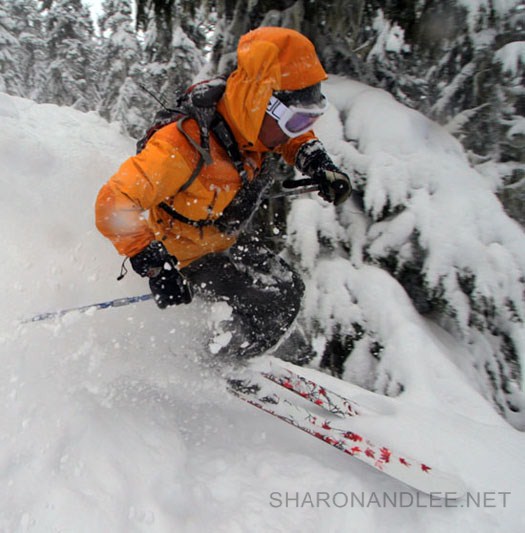
Blackcomb inbounds on G3 Tonics.
Zenoxide is not a beginner or a strong intermediate’s ski. The G3 Zenoxide in the 185 length rewards strong, aggressive skiing. I loved its stiffness from tip to tail; so much so that I would rail Zenoxide into turns, give the tail a slight bit of pressure and accelerate. Give the G3 Zenoxide speed, put in power and it wants more. On the other hand, if you are a content meadow-skipper preferring shorter radius turns on gentler slopes or always in the back-seat or have technique hiccups, look at something more forgiving, with more sidecut and perhaps a bit softer.
On to the Tonics, which I found quite similar to the Zenoxide. Just as comfortable at speed, perhaps a touch easier to ski in trees and not quite as poppy into and out of the turns (but by no means did this plank feel dead). I can’t say that I noticed that the Tonics were heavier than the Zenoxide but, all things being equal, I’d prefer the lighter ski to the heavier and the less turny ski over the more turnier.
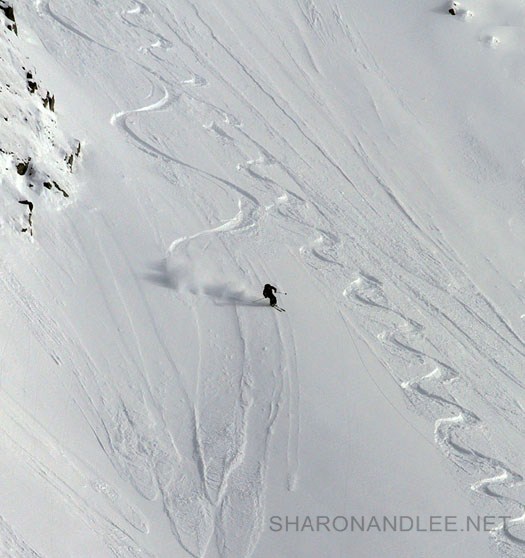
Kitchen Envy - Battle Abbey, Selkirks BC on a G3 Zenoxide.
In terms of tourability, main thing is Zenoxide is fairly light for its weight (1695g per single ski – verified). I had no issues with the length in kickturns. I appreciate the flattish tail and the skin tab cutout plus the tail material which provides good grip for the camming action of a climbing skin. I also appreciate the flattish tails (and for the same reason loathe twin tips) for the reason that you can easily use the Zenoxides as pickets when boot-packing or when setting a quickie snow anchor. All in all, a ski that’s well thought out for touring
G3 Alpinist Skins
Our test skis all came equipped with G3 Alpinist Nylon Skins. The glue on these skins kept the skins on at temperatures below -25 degrees celsius (ie brrrrrr) when glue on other skins was failing. Sharon had issues on steep packed skin tracks where she would slide back; Lee reported no issues. Thus, WildSnow conclusion is Alpinist skins have average climb traction. (Editor’s note: We concur. In extensive testing here in Colorado we’ve found the Alpinist skins to have average to slightly below average grip, but above average glide.)
The initial glide on the skins was grabby at first, but did improve as they wore in. The improvement was so marked that we’re both happy to opine that the G3 Alpinists has the best glide of any skins we own – comparable to mohair/nylon blend climbing skins. The rotating tip connector on the Alpinist skins is a new feature this year and seems to be an improvement over the simple tabs of G3 skins from past years. The camming action ensures secure attachment at the tail and makes it easy (yet secure to attaching and detach skins).
We haven’t had enough time on the skins to report back on long-term use and wear. All we can say is that after 20 or so days; the skins are not wearing thin in spots and the glue is still evenly spread over the skins and working fine.
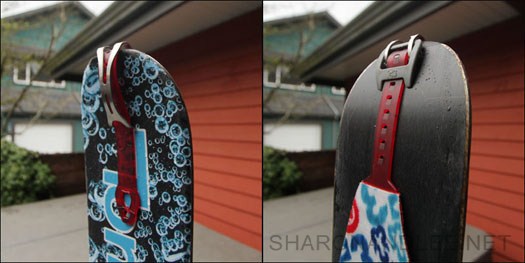
New camming tail on the G3 Tonic skis (picture is of last years G3 Tonics in the 177 length - Sharon was playing with ski lengths!
G3 Onyx Binding
The Onyx tech binding has been extensively reviewed by Wildsnow. Nonetheless, since our initial Wildsnow reviews this grabber has undergone several iterations and refinements.
New for 2011 are stronger Onyx toe pins and tightened tolerances, along with other refinements. Red plastic on the toe piece identifies where you need to press down to open the toe jaws. The spring tension has also been reduced on the toe piece so that boot insertion is easier. Different tolerances were used in the metal which engages the brakes to help prevent brake deployment issues which plagued the initial version of the brakes. As with previous iterations, Onyx goes from RV 6 – 12. Mounting hole patterns are the same as or partially match many other leading tech binding brands.
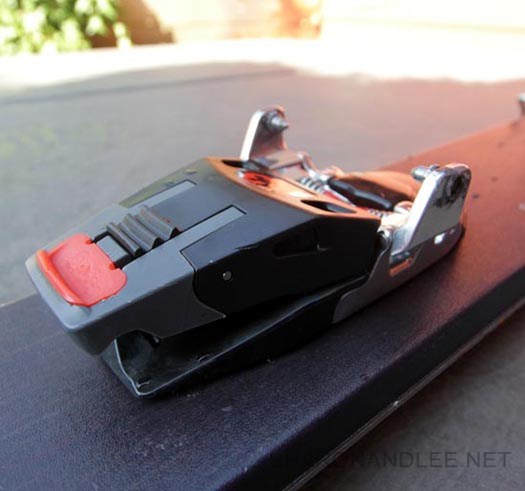
G3 Onyx toe piece side profile. Photo below shows toe engagement mechanism which has potential for snow and ice jamming.
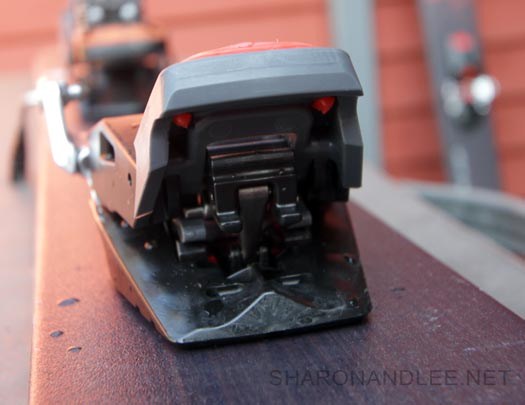
G3 Onyx toe view.
Once you’ve familiarized yourself with the Onyx it is easy to use. Pros/cons outlined below:
Onyx Positives
* Tech bindings are cool. Really. Go back to a frame/plate binding, or god forbid, a telemark binding and you’ll feel like you’re striding in molasses compared to any tech binding. The Onyx might be heavier than most other tech bindings but shares that same glorious natural striding motion, and you don’t lift the binding as your foot hinges up (which saves more energy than one would think).
* The Onyx brakes work very well. They’re long so they dig into the snow and deploy when needed.
* Onyx swap plate is a terrific idea and lets you share one binding between as many pairs of skis as desired (by mounting additional plates on the skis).
* Onyx heel unit is well designed and easy to deploy (see below pictures – use your pole to engage the red heel lever). It’s easy to switch from ski to walk and vice-versa. It’s not subject to ice buildup and auto-rotation.
* When skiing on hardpack Onyx feels like it has a bit of cushioning compared to other, exceptionally harsh tech bindings; small bumps and hits seem to get absorbed and not transmitted to the skier. We suspect (but have no proof) that the plastic swap plate or some other part of the Onyx’s construction provides some form of cushioning and elasticity to the binding. This is more a question of feel than a quantitative observation. Suffice it to say that Onyx seems to provide a smoother ride.
* Other than in unusual circumstances (described below), Onyx’s toe piece is largely immune to icing up; a problem which can occur with other tech bindings especially in wetter stickier snow.
* At 850g (single binding plus brakes) Onyx is a good deal lighter than any frame binding.
Onyx Negatives
* While we still find having to press down on the toe piece to attach your toe awkward in some situations – such as narrow, rocky confined spaces or in deep loose powder – we were always able to securely attach the toe. There’s no denying that this mechanism of entry is still (in our opinion) the achilles heel of the Onyx system. It adds an extra layer of fiddle to the already inherently fiddly tech system.
* In one touring situation where temperatures were consistently -25 celsius over 4 days, there was significant ice-buildup in the toe piece of Onyx (see above picture). This snow/ice-buildup interfered with the ratcheting mechanism in the toe so one could not lock out the toe for touring mode. To be clear, this buildup happened over a period of several days where the ski was not brought indoors and ice accumulated over a period of several days. The fix is to ensure the toe piece is clear of snow.
* At 850g (single binding plus brakes) Onyx is a good deal heavier than most other tech bindings.
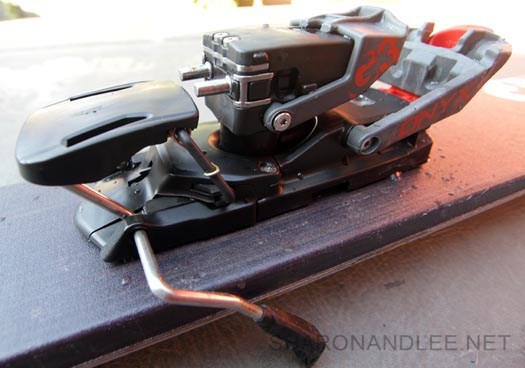
Onyx heel unit in walk mode with heel lifter deployed (top) and ski mode (bottom). In the bottom picture note the small metal hook which engages the brakes to hold them up when in ski mode.
G3 Speed Pro Avalanche Probe
New for 2011 from G3’s research enginerds is the Speed Pro cable attachment. We’ve both had G3 avalanche probes for probably 15 years and gotten used to having to screw the cap into the end to secure it. The new cable attachment is slick and will speed up probe assembly. Essentially there is a knob near the end of a cable that moves inside the probe. Pull the knob past the end of the probe and angle the cable into the top groove thus locking the cable in place. Fast and smooth.
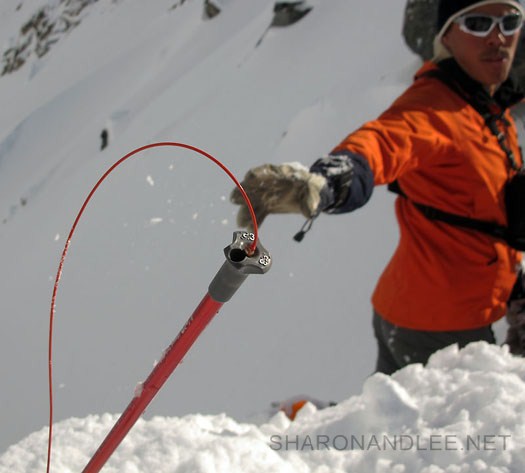
G3 Speed Pro probe in 320 cms length.
(WildSnow guest bloggers Lee Lau and Sharon Bader are avid skiers and outdoors people. They have over fifteen years of experience backcountry skiing. In the “off-season” Lee is occasionally found working in his day job as an intellectual property lawyer when he is not mountain biking with Sharon. As a resident of Vancouver and Whistler, British Columbia, their playground extends mainly to Western Canada, including South West B.C. and the Selkirks. Lee and Sharon share experiences at www.sharonandlee.net)
Beyond our regular guest bloggers who have their own profiles, some of our one-timers end up being categorized under this generic profile. Once they do a few posts, we build a category. In any case, we sure appreciate ALL the WildSnow guest bloggers!

